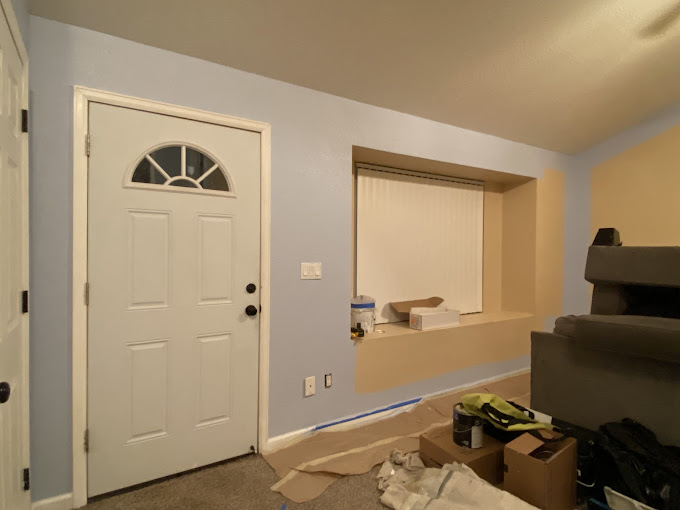A fresh coat of paint has the power to transform any space, making it more vibrant, welcoming, and valuable. In a competitive real estate market like Denver, CO, homeowners are constantly looking for ways to enhance the appeal of their properties. One of the most effective yet budget-friendly methods to increase home value is high-quality interior painting. Whether you’re preparing to sell or simply want to refresh your living space, investing in professional home painting services can make a significant difference.
Key Takeaway: High-quality interior painting not only improves aesthetics but also adds tangible value to your property, creating a more attractive and comfortable home environment.
The Impact of Interior Painting on Home Value
Enhancing Aesthetic Appeal and First Impressions
Color plays a crucial role in shaping a home’s ambiance. A well-chosen paint palette can make rooms appear larger, brighter, and more inviting. Neutral tones such as warm grays, soft beiges, and crisp whites are timeless choices that appeal to a wide range of buyers. A professional interior painting service ensures even application, clean lines, and a polished finish, which all contribute to a lasting positive impression.
Homeowners often underestimate the effect of minor imperfections such as chipped paint, outdated colors, or scuff marks. A fresh coat of paint eliminates these flaws, giving the home a well-maintained and cared-for look. If you plan to sell, potential buyers will immediately notice the effort put into upkeep, increasing their willingness to pay a premium for a move-in-ready home.
Protecting Walls and Surfaces from Damage
Beyond aesthetics, interior painting serves a protective function. Over time, walls accumulate dust, moisture, and stains that can deteriorate surfaces. Quality paint creates a barrier against these elements, preventing mold growth, moisture damage, and everyday wear and tear. A professionally applied layer of paint using high-quality materials can extend the life of drywall, trim, and molding, ensuring your home remains in top condition for years to come. Drywall repair before painting also enhances durability by smoothing out imperfections and ensuring an even surface.
Increasing Energy Efficiency and Comfort
Paint finishes contribute to indoor temperature regulation by affecting light absorption and reflection. Lighter shades help maintain cooler indoor temperatures by reflecting sunlight, reducing the need for excessive air conditioning. In contrast, darker colors absorb heat, making rooms feel warmer during colder months. Strategic color choices can improve overall energy efficiency, helping homeowners lower utility bills while maintaining a comfortable indoor climate.
Choosing the Right Paint for Different Spaces
High-Traffic Areas: Durability and Stain Resistance
Spaces such as hallways, kitchens, and living rooms experience the most daily wear and tear. Choosing a durable, washable paint finish like satin or semi-gloss ensures that walls can withstand frequent cleaning without losing their color or sheen. For kitchens, a high-quality lime wash finish provides a breathable and eco-friendly option that resists moisture and grease buildup.
Bedrooms and Living Spaces: Creating a Relaxing Atmosphere
For spaces intended for relaxation, such as bedrooms and family rooms, matte and eggshell finishes are ideal. These finishes offer a soft, non-reflective appearance that minimizes surface imperfections and promotes a cozy ambiance. Soft blues, greens, and neutrals are excellent choices for bedrooms, fostering a tranquil environment conducive to rest and relaxation.
Kitchen Cabinet and Banister Painting: Refinishing for a Modern Look
Updating kitchen cabinets with a fresh coat of paint is an effective alternative to a costly remodel. Cabinet painting revitalizes worn-out surfaces, making them look brand new. The same concept applies to banister painting, which enhances staircases and railings, giving the home a more sophisticated look.
Answering Common Questions
What is the best type of paint for interior walls?
The best type of paint depends on the room’s function. Satin and semi-gloss finishes are ideal for high-traffic areas due to their durability, while matte finishes work best in low-traffic spaces for a smooth, elegant look.
How often should interior walls be repainted?
Most interior walls should be repainted every 5-7 years, but high-traffic areas like hallways and kitchens may need more frequent touch-ups.
Can interior painting increase my home’s resale value?
Yes! A fresh coat of paint enhances a home’s appeal, making it more attractive to potential buyers and increasing its market value.
Final Thoughts: Elevate Your Home with Dream Painting LLC
Whether you’re looking to refresh a single room or repaint your entire home, investing in professional painting services pays off in multiple ways. From increasing curb appeal to protecting walls and creating a more comfortable living space, high-quality interior painting is a worthwhile investment.
At Dream Painting LLC, we specialize in expert interior and exterior painting services tailored to your needs. Contact us today to discuss your project and bring your vision to life with stunning, high-quality results.

